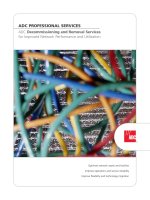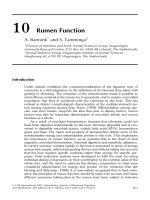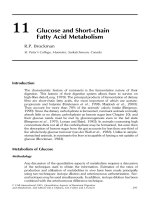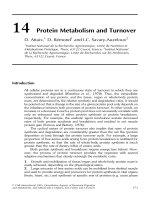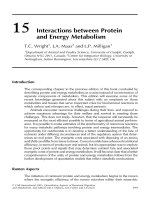Tài liệu Functional Specification of JPEG Decompression. and an Implementation for Free ppt
Bạn đang xem bản rút gọn của tài liệu. Xem và tải ngay bản đầy đủ của tài liệu tại đây (228.05 KB, 16 trang )
Functional Sp ecication of JPEG Decompression,
and an Implementation for Free
Jeroen Fokker
Department of Computer Science, UtrechtUniversity
P.O.Box 80.089, 3508 TB Utrecht, The Netherlands
, />August 7, 1995
Abstract
A decoder for images compressed by the JPEG algorithm is stated in the pure functional
programming language Gofer. The program can be regarded as a mathematical specication
of the decompression algorithm the concise description (which is included in full) is very
suitable for learning about the algorithm. At the same time the `specication' is an executable
program, whichshows the usefulness of a functional programming language as a prototyping
tool for graphics algorithms.
All functions are dened as much as possible at the function level, i.e. as compositions
of other functions. A tutorial on the important concept of a `State Monad', whichplays an
important role in the program, is included. From a functional programming theoretical point
of view, the new technique of currying a state monad, whichisintroduced, and its application
in the program, are interesting.
1 Intro duction
JPEG is a standard for compressing images that has become very popular recently. Unlike general
purpose compression algorithms, it exploits redundancy resulting from the two-dimensional struc-
ture of pictures, and from the continuous nature of photographic color images. Furthermore, it
oers the possibility to let the compression lose some information, whichisintended to be hardly
noticeable bythehuman viewer. JPEG is named after its designer, the Joint (ISO and CCITT)
Photographic Expert Group.
In the JPEG algorithm various techniques are combined: Human encoding, run-length encoding,
dierential encoding, quantization, cosine transform, and data reordering. A general introduction
to the algorithm is given byWallace Wall91] in a 17 page article. It contains a numeric example
which is quite instructive however the information is not intended to be detailed enough to be
able to implement the algorithm. For that, you would need the ocial (draft) standard ISO93]
(210 pages) and/or the bo ok that explains it PeMi93] (334 pages). The ISO description in the
standard is not so nice as Wallace's article: algorithms are given by unstructured owcharts, use
fuzzy identiers and lots of indices and pointers, and are laid out po orly.Atypical example is:
CODE=(SLL CODE 1)+ NEXTBIT
J=VALPTR (I)
J=J+CODE-MINCODE (I)
Iwould therefore not recommend the ISO document for learning about the JPEG algorithm.
In some circles, functional programming has the reputation of being an academic plaything, only
useful for toy problems like `bonacci' and `8 queens' and maybe some AI applications. This might
1
be true for the earlier functional languages, but certainly not for the modern, polymorphically
typed and lazily evaluated languages like Haskell HuFa92], Gofer Jone94] and Clean PlEe95].
We will prove this by giving an implementation of a JPEG decoder in the Gofer language. This
article can serveasa:
Specication. The program has the conciseness of a mathematical description, and thus acts
as a `functional specication'. Unlike other specication formalisms, the language has a well
dened semantics, and an interpreter that can checktype correctness.
Teaching text. The JPEG format can be understoo d by studying the decoder. Due to the
abstraction mechanisms in the language, various aspects of the algorithm can be isolated
and understoo d separately.
Implementation. The program is executable, and has been applied successfully to decode
images. The program is very slow (it takes 14 minutes to decode a 384 256 image).
Running time could be improved considerably by using a compiler instead of an experimental
interpreter, and by optimizing some functions (the cosine transform function in section 4.2
is a goo d candidate for this). Wehave not done so, because we consider the specication
aspect of the program more important.
Functional programming tutorial and case study. Some interesting programming techniques
are used and explained. It shows that a functional language can be used for real life problems
in graphics. In particular, it shows that by using a `state monad', input-consuming functions
can be dened, while keeping the benets of abstraction in a functional language.
This article assumes no knowledge of JPEG or any of its algorithms, nor of specialized functional
programming techniques. Basic knowledge of functional programming (recursion, manipulation
of lists and the use of types, as described in the rst few chapters of e.g. BiWa88] or Jone94])
may be helpful. However, it even may not be necessary, because the most important notions and
notations are summarized in section 2.
The rest of this article is divided in two parts: sections 2{3 and sections 4{6.
Sections 2{3 describe some general purpose functions, that are needed in the sequel and that
happen not to be part of the standard prelude of most languages. In section 2 matrix manipulation,
bit lists and binary trees are dealt with. In section 3 the notions of `state function' and `monad'
are introduced, and some utilities to manipulate them. Experienced functional programmers may
want to skip these sections, although they mightwanttotake a look at the end of subsection 3.4,
where the new technique of currying state functions is described.
The JPEG decoding algorithm proper is dealt with in sections 4{6. In section 4 the basic algo-
rithms used by JPEG are dened: Human coding, the Discrete Cosine Transform (DCT), and
quantization. In section 5 functions for parsing the interleaved image data, and the image header
are dened. (Subsection 5.1 is a particularly nice example of using types as a guide to design
functions). Section 6 contains the main program of the JPEG decoder, which calls the parser,
decodes the image, and converts it to another image format. Section 7 reects on the program
and the methodology.
2 A functional library
2.1 Auxiliary functions
In the functions in this article, we will use standard functions on lists, like map, concat, zipWith
and transpose. These functions are dened in the standard prelude of most functional languages.
Six functions of general nature that we need are not dened in the Gofer prelude. They are dened
in this section, and may also serve to get used to the Gofer syntax.
The result of integer divisions is truncated. Weprovide a version which calculates the ceiling dn=de
of a division instead. In the type of the function, an arrow is written not only between the type of
the parameters and the result, but also between the two parameters. The type a ! b ! c is to be
2
read as a ! (b ! c), which stresses the fact that a function may also be partially parameterized
with its rst parameter only. This mechanism is known as `Currying'.
ceilDiv :: Int -> Int -> Int
ceilDiv n d = (n+d-1)/d
Partial parametrization is also useful when dening functions. The function multi takes an integer
n and a list, and replicates each element of the list, which remains unnamed, n times.
multi :: Int -> a] -> a]
multi n = concat . map (copy n)
The function is dened as a functional composition (denoted by the standard operator `dot') of
the map (copy n) function (whichturnsevery elementinto a list of length n) and the concat
function (which concatenates all lists into one big list). The function multi couldalsohavebeen
dened by explicitly naming the second parameter: multi n xs = concat (map (copy n) xs).
However, this is avoided whenever possible in order to not overwhelm the reader with unnecessary
names. Occasionally,we will also need to compose functions of two parameters. As this is not
a standard function, we will dene it here. The function o maybeusedasaninxoperatorby
writing its name in back quotes.
infixr 9 `o`
o :: (c->d) -> (a->b->c) -> (a->b->d)
(g`o`f)xy=g(fxy)
In addition, we dene an explicit denotation ap for functional application, and a variant ap' with
its parameters reversed:
ap :: (a->b) -> a -> b
apfx =fx
ap' :: a -> (a->b) -> b
ap'xf=fx
An unorthodox use of functions is their use as updatable association tables. The function subst
modies a given function with respect to one possible parameter. The predicate Eq a => in front
of the type means that the function is only dened for types a for which equality is dened. In
section 6 we will use this function for integer indexed lookup tables, for whichweprovide the type
synonym Table here.
subst::Eqa=>a->b->(a->b)->(a->b)
substietj | i==j = e
| otherwise= tj
type Table a = Int -> a
2.2 Matrix manipulation
Matrix manipulation is a rewarding area for functional programming, as the denitions of most
operations are short and elegant and don't need lots of indices as in many other formalisms. More
important, we will need these functions in section 4 for the DCT operation, and in section 6 for
color space conversion. A matrix is simply a list of lists, of whichwe will assume that the rows
have equal length. The dimensions of a matrix can be indicated by a pair of twointegers.
type Dim = (Int,Int)
type Mat a = a]]
We provide a function matmap which applies a function to all elements of a matrix, a function
matconcat which collapses a matrix of sub-matrices into one big matrix, and a function matzip
which transforms a list of matrices into a matrix of lists of corresponding elements.
matmap :: (a->b) -> Mat a -> Mat b
matmap =map.map
matconcat :: Mat (Mat a) -> Mat a
3
matconcat = concat . map (map concat . transpose)
matzip :: Mat a] -> Mat a]
matzip = map transpose . transpose
The classic operations from linear algebra (inner product of vectors and linear transformation of
avector by a matrix) presuppose the existence of arithmetical operations on the elements, which
is indicated by the Num a predicate in frontofthetype.
inprod :: Num a => a] -> a] -> a
inprod = sum `o` zipWith (*)
matapply :: Num a => Mat a -> a] -> a]
matapply m v = map (inprod v) m
Inner product is dened as elementwise multiplication followed by summation matrix application
as calculating the inner product of a vector with all rows of the matrix.
2.3 Bit Streams
Ofamoremundane nature are some functions that address the individual bits in a byte, and
by extension, in a string. In the same vein the function byte2nibs splits a byte in two four-bit
nibbles. The standard function rem is used to calculate the remainder after division.
type Bits = Bool]
byte2bits :: Int -> Bits
byte2bits x = zipWith (>=) (map (rem x) powers) (tail powers)
where powers = 256,128,64,32,16,8,4,2,1]
string2bits :: String -> Bits
string2bits = concat . map (byte2bits.ord)
byte2nibs :: Int -> (Int,Int)
byte2nibs x = (x/16, x`rem`16)
With some eort, the rem operation could be avoided by repeated subtraction, but as our goal
is a clear specication rather than an ecient implementation, we don't do that here. In other
languages shifting and masking operators may be used.
2.4 Binary Trees
Binary trees, which will be used to represent Human trees in section 4, are dened by an algebraic
type denition. Information is stored in the Tips of the tree, there maybe Nil ends, and in Bin
branching points only two subtrees are given.
data Tree a = Nil
| Tip a
| Bin (Tree a) (Tree a)
The function map can be overloaded to also operate on trees, by making Tree an instance of
Functor, the class of all types supporting the map function.
instance Functor Tree where
map f Nil = Nil
map f (Tip a) = Tip(fa)
map f (Bin x y) = Bin (map f x) (map f y)
4
3 Mo delling of State
3.1 State Functions
Modelling of state has long been a problem when using pure functional languages, whichby their
nature are side-eect free. However, recently it has been discovered that state can be adequately
dealt with using so-called `monads' Wadl92, Jone93, Jone95].
A `state function from s to r', or StFun s r for short, is a function that operates on a type s
(the `state') and yields not only a value of type r (the `result'), but also a value of type s (the
`updated state'). An algebraic type denition, involving an explicit conversion ST is used rather
than a type synonym denition, as state functions are to be regarded as an abstract data type, to
be manipulated only by the functions below.
data StFun s r = SF (s -> (r,s))
Firstly, state functions are made an instance of Functor, where the map function applies a given
function to the `result' part of a state function:
instance Functor (StFun s) where
map h (SF f) =SFg
where g s = (h x,s')
where (x,s') = f s
Furthermore, state functions are made an instance of the Monad class. For this, a function result
and a function bind need to be dened that full certain laws. In this instance, the result
function constructs a state function which delivers some result x without changing the state, and
the bind function composes two state functions in an intricate way:
instance Monad (StFun s) where
result x =SFg
where g s = (x,s)
SF f `bind` sfh = SF g
where g s = h s'
where (x,s') = f s
SF h =sfhx
We will not use the bind function explicitly in the sequel. Instead wemakeuse ofasyntactic
sugaring known as `monad comprehension', provided in the Gofer language Jone94], whichis
discussed in subsection 3.3. A state function can be applied to an initial state using the function
st'apply. This yields the proper result only, and discards the nal state.
st'apply :: StFun a b -> a -> b
st'apply (SF f) s = x
where (x,_) = f s
3.2 Primitive State Functions
In the JPEG decoder, as a state we will basically use a list. We provide three primitive functions
that operate on list states, from which the more involved ones can be constructed. The empty
state function reports whether the list in the state is empty, and leaves the state unmodied.
The item state function returns the rst element of the list in the state (which is assumed to be
non-empty), and removes that element from the list. The peekitem state function returns the
rst element without removing it from the list.
empty :: StFun a] Bool
empty = SF f
where f]=(True, ])
f xs = (False, xs)
item :: StFun a] a
5
item = SF f
where f (x:xs) = (x, xs)
peekitem :: StFun a] a
peekitem = SF f
where f ys@(x:xs)=(x,ys)
A fourth primitive function meets a more special purpose. In the JPEG format, a binary data
stream is terminated byatwo-byte marker consisting of an `\xFF'byte and a non-zero byte. If
an `\xFF'byte occasionally occurs in a data stream, it is padded by an extra zero byte. The state
function entropy below gets one segment of binary data, taking care of the padding, and leaves
behind as nal state a list that begins with the terminating marker.
entropy :: StFun String String
entropy = SF f
where f ('\xFF':'\x00':xs) =let(as,bs)=fxsin('\xFF':as,bs)
f ys@( '\xFF':_ ) = (],ys)
f( x:xs) =let(as,bs)=fxsin(x:as,bs)
3.3 Auxiliary State Functions
The state function item gets one character from a string state, removing it from the state. The
state function byte does the same, but yields its result as an integer rather than as a character.
It can be dened as map ord item (where ord is the primitivechar-to-int function). Recall that
map was overloaded in subsection 3.1, so that map hf applies a function h to the result part of a
state function f .We write the denition however in the form:
byte :: StFun String Int
byte =ordc|c<-item]
nibbles :: StFun String (Int,Int)
nibbles = byte2nibs a | a <- byte ]
These look like list comprehensions, but as map is overloaded to operate on arbitrary Functors, so
is the comprehension notation. From the type in the expressions above it can be inferred that these
comprehensions are actually `string-state function comprehensions'. The comprehension notation
is especially useful when more than one generator is being used:
word :: StFun String Int
word = a*256+b | a<-byte, b<-byte ]
Comprehensions with multiple generators may be used not only for lists, but for arbitrary Monads,
and hence in particular for state functions. The semantics of comprehension like this is dened
using the result and bind functions (see Jone94]), but can be more easily understoo d intuitively:
a 16-bit word can be fetched from a string state by successively fetching twobytes and combining
them arithmetically.
3.4 State Function Combinators
The generalized comprehension notation will be used in this subsection to dene some transfor-
mation utilities (`combinators') for state functions. The function list transforms a list of state
functions into one state function with a list as result. As it makes use of no particular property
of state functions, the function is actually applicable to any monad (for the list monad, the list
function boils down to transpose).
-- list :: StFun s r] -> StFun s r]
list :: Monad m => m a] -> m a]
list ] = result ]
list (f:fs) = x:xs | x<-f, xs<-list fs]
The function exactly transforms a state function into one that applies the original one a given
6


